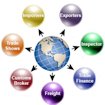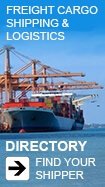Breaking Into The Trade Game: A Small Business Guide
Intro | Chapter 1 | International Business Plan | Chapter 2 | Chapter 3 | Chapter 4 | Chapter 5 | Chapter 6 | Chapter 7 | Chapter 8 | Part 2 | U.S. Department of Commerce | Small Business Development Centers | Foreign Chambers of Commerce in the U.S. | International Trade Organizations | Publications and Information Sources | International Calling CodesChapter 7 - Transporting Goods Internationally
Now that financing has been arranged, steps must be taken to ensure that the goods for export are packed and shipped properly to reach their destination. When transporting goods internationally, proper documentation and correct packaging are critical to the export process.
One of the main differences between selling domestically and exporting is the documentation required. Providing proper documentation with your shipments is essential, if the goods are to arrive safely and on time.
Although the paperwork involved in exporting may be more burdensome and costly than that required for domestic sales, it should not deter you. Consider the case of Hood Equipment Inc. of Iron River, Wisconsin:
"We began exporting our forestry equipment in 1977. Now exports amount to 40 percent of our sales. While export documentation requirements can be time consuming, 40 percent of our sales depend on it so we have to do it," says export manager Joyce Hood. Ms. Hood credits her company's international freight forwarder as "a great help."
THE ROLE OF THE FREIGHT FORWARDER
The international freight forwarder acts as an agent for the exporter in moving cargo to the overseas destination. These agents are familiar with the import/export rules and regulations of foreign countries, methods of shipping, United States government regulations and the documents connected with foreign trade.
Freight forwarders can assist with an order from the start by advising the exporter of the freight costs, port charges, consular fees, costs of special documentation and insurance costs as well as their handling fees -- all of which help in preparing the pro-forma invoice and price quotations. Freight forwarders may also recommend the best type of packing for protecting the merchandise in transit; they can arrange to have the merchandise packed at the port or containerized. The cost for their services is a legitimate export cost that should be figured into the price charged to the customer.
When the order is ready to ship, freight forwarders should be able to review the letter of credit, commercial invoices, packing list to ensure that everything is in order. Freight forwarders can also reserve the necessary space on board an ocean vessel, if the exporter desires.
The exporter may ask the freight forwarder to make arrangements with the customs broker to ensure that the goods comply with customs export documentation regulations. In addition, they may have the goods delivered to the carrier in time for loading. Freight forwarders may also prepare a bill of lading and any special required documentation. After shipment, they can forward all documents directly to the customer or to the paying bank.
In preparing your goods for international transport, you must first determine what mode of transport you will use. When shipping to Mexico and Canada, land transportation may be the preferred method of transport. Other forms of international shipments are sea and air.
Maritime shipping is almost always slower and less expensive than air.
However, an exporter must factor in the additional costs of sea freight, such as surface transportation to the dock. Another factor is the time value of money: payment may not be made until the ship reaches its destination -- ocean freight can be significantly longer than air freight. Your international freight forwarder can assist in weighing the pros and cons of different modes of transportation.
Once you have decided on the best mode of transporting your goods, you must begin to compile the necessary documents.
DOCUMENTATION
Export Documentation Checklist -- Documents Prepared Before the Shipment
Commercial Invoice/Consular Invoice
After the pro-forma invoice is accepted, the exporter must prepare a commercial invoice. The commercial invoice is necessary for both the exporter and importer.
The exporter needs the commercial invoice to prove ownership and secure payment. The description of the goods on the commercial invoice must correspond exactly to the description in the letter of credit or other method of payment. There can be no exceptions.
The importer needs the commercial invoice since it is often used by Customs authorities to assess duties. For this reason, it is common practice to prepare a commercial invoice in English and in the language of the destination country. The freight forwarder can advise you when a translated copy is necessary.
Similar to a commercial invoice, a consular invoice is required by certain countries. The consular invoice must be prepared in the language of the destination country and can be obtained from the country's consulate, and often must be "consularized."
In some countries, the commercial invoice must be prepared on a special form known as a "customs invoice." Your importer may request this of you.
Export License
Export controls are based on the type of goods being shipped and their ultimate destination. Most exports do not require a license, per se. Technically, most exports are shipped under a "general" license which does not require an application.
Should your particular export be subject to export controls, then a "validated" license must be obtained. In general, your export would require a "validated" license if export of the goods would: threaten United States national security; affect certain foreign policies of the United States; or create short supply in domestic markets. Check with the U.S. Department of Commerce's (DOC's) Bureau of Export Administration (BEA) to determine if your product may be subject to export controls (see Part II, The Exporter's Directory).
Shipper's Export Declaration (SED)
The most common document used by exporters is the Shipper's Export Declaration (Form 7525-V), for mail shipments valued at more than $500, and required for other shipments valued at more than $2,500. In addition, a SED must be prepared for all shipments covered by an Individually Validated Export License (IVL), regardless of value. The SED enables the Bureau of the Census to monitor for statistical purposes the kinds of products being exported from the United States. The SED must be presented to the carrier before the shipment departs.
A sample SED follows:
A Shipper's Export Declaration Form 7525-V cannot be reproduced here. The form is available through the Superintendent of Documents, Government Printing Office, Washington, DC 20402 and local Customs district offices.
Three items appearing on the SED may cause confusion:
Item 14, "Schedule B Description of Commodities"
You will need to determine the official description of the commodity you are shipping by obtaining a copy of the United States government publication entitled, Harmonized System/Schedule B Statistical Classification of Domestic and Foreign Commodities Exported from the United States and then transfer the appropriate description onto the SED. This is available from the Government Printing Office and from most freight forwarders.
Item 21, "Validated License No./General License Symbol"
If your product for export is controlled, the "validated" license number is inserted in this space. If you are exporting under a "general license," one of eight possible "General License Symbols" must be noted. The three most commonly used symbols are:
- G-Dest (General Destination): authorizes the export of any items not requiring a validated license
- GLV (General License Limited Value): authorizes the export of a single shipment of limited-value items
- GTE (General License for Temporary Export): authorizes the export of items for trade shows, training or temporary use abroad
Item 22, ECCN (Export Control Commodity Number)
Only necessary when a "validated" license is required, the ECCN is the number assigned to your commodity from the Bureau of Export Administration's Commodity Control List. This special number must be supplied on the SED.
Shipper's Export Declaration
SED forms can be obtained through international freight forwarders, the
Government Printing Office or local Customs district offices. The "Exact
Way to Fill Out the Shipper's Export Declaration" is available from the
Bureau of the Census, Washington, DC 20233.
Certificate of Origin (where applicable)
Although the commercial invoice may contain a statement of origin, some countries (particularly those subject to certain free trade treaties, such as Canada or the Caribbean Basin) require Certificates of Origin. Certificates of Origin allow for preferential duty rates if the exporter's country has an agreement with the importer's country to allow entry of certain products at lower tariffs.
Export Packing List
Considerably more detailed and informative than a standard domestic packing list, an export packing list itemizes the material in each individual package and indicates the type of package: box, crate, drum, carton, etc. It shows the individual net, legal, tare and gross weights and measurements for each package (in both U.S. and metric systems). Package markings should be shown along with the shipper's and buyer's references. A copy of the packing list should be attached to the outside of a package in a waterproof envelope marked "packing list enclosed." The list is used by the shipper or forwarding agent to determine the total shipment weight and volume and whether the correct cargo is being shipped. In addition, customs officials (both U.S. and foreign) may use the list to check the cargo. The original packing list should be forwarded along with your other original documents in line with the conditions of sale.
Insurance Certificate
If the exporter is providing insurance, a certificate will be needed confirming the type and amount of coverage for the goods being shipped. Normal accepted practice for coverage is 110 percent of the CIF value. This certificate should be made in negotiable form and must be endorsed before submitting to the bank.
Inspection Certificate
Many foreign purchasers request that the seller certify that the goods being shipped meet certain specifications. This certification is usually performed by an independent inspection firm.
Documents Used During the Inland Movement of the Goods
Shipper's Instructions
As an exporter, you are responsible for providing your freight forwarder with the necessary information regarding your shipment. The more details you provide, the greater the chances of your goods moving problem free. Your freight forwarder can provide you with a commonly used form for noting instructions.
Inland Bill of Lading
Inland bills of lading document the transportation of goods between inland points and the port from where the export will emanate. Rail shipments use "waybills on rail." "Pro-forma" bills of lading are used in trucking.
Delivery Instructions
This document is prepared by the freight forwarder giving instructions to the trucking or railroad company where the goods for export are to be delivered.
Dock Receipts
This document transfers shipping obligations from the domestic to the international carrier as the shipment reaches the terminal.
Bill of Lading/Air Waybill
Bills of lading and air waybills provide evidence to title of the goods and set forth the international carrier's responsibility to transport the goods to their named destination.
There are two types of ocean bills of lading used to transfer ownership:
- Straight (non-negotiable): provides for delivery of goods to the person named in the bill of lading. The bill must be marked "non-negotiable."
- Shipper's Order (negotiable): provides for delivery of goods to the person named in the bill of lading or anyone designated.
The shipper's order is used with draft or letter-of-credit shipments and enables the bank involved in the export transaction to take title to the goods if the buyer defaults. The bank does not release title to the goods to the buyer until payment is received. The bank does not release funds to the exporter until conditions of sale have been satisfied.
When using air freight, "air waybills" take the place of bills of lading. Air waybills are only issued in non-negotiable form, therefore the exporter and the bank lose title to the goods once the shipment commences. Most air waybills also contain a customs declaration form.
PACKAGING
Goods shipped for export require substantially greater handling than domestic shipments. The exporter must pack the goods to ensure that the weight and measurements are kept to a minimum, breakage is avoided, the container is theft proof, and that the goods do not suffer the stresses of ocean shipment, such as excess moisture.
In addition to proper packing, the exporter should be aware that certain markings are necessary on goods transported internationally. Some countries require that the country of origin be marked on the outside of the container, and even have regulations as to how the mark of origin should appear.
The second type of marking with which the exporter should be familiar is labeling. Food and drugs must often carry special labeling as determined by the laws of the country of destination.
Third, certain "shipping marks" must appear on the outside of the package. The weight and dimensions should be visible and any special instructions should be shown, and you may want to repeat these instructions in the language of the importer's country.
If your business is not equipped to package your goods for export, there are export packaging companies which can perform this service for you. Ask your international freight forwarder for a list of export packaging companies in your area.
Many businesses, after achieving success in exporting, or as an alternative to exporting, contemplate joint ventures or licensing agreements with foreign companies to produce goods overseas. Some companies even set up their own off-shore operations. "Strategic Alliances and Foreign Investment Opportunities" are the topic of Chapter 7.
Next: Chapter 8 - Strategic Alliances & Foreign Investment Opportunities
- Source from manufacturers worldwide
- Find inspection, freight services and more
- Access global trade resources and guides
- Be part of largest global trade community and much more...
- Be where your customers are!
- Promote and market your services
- Receive direct quote requests
- Back office support, set up regional offices and much more...



